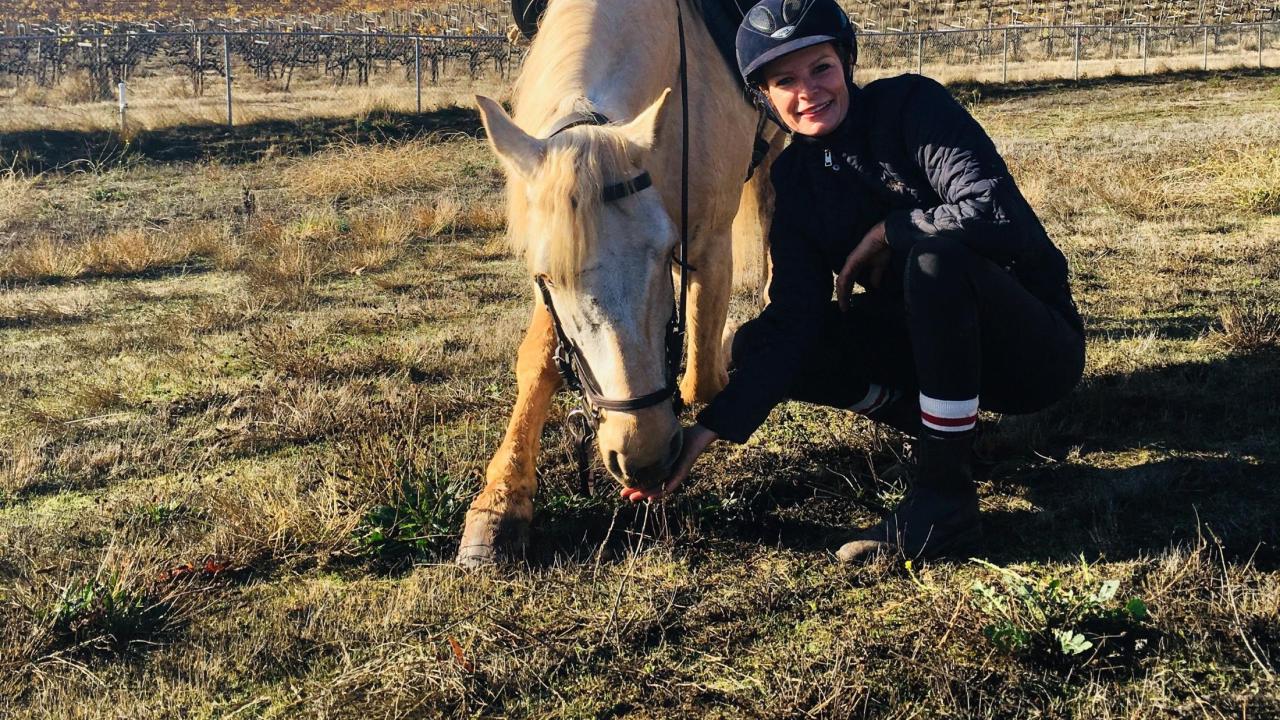
UC Davis Veterinarians Team with Physician to Remove Tumor in Horse
--Team Makes History with First-Ever Image-Guided Sinus Tumor Removal--
“Case of the Month” – February 2019
Honesto, a 6-year-old Lusitano-Arabian cross gelding, was found to have a massive sinus osteoma (a benign tumor created from new bone growth), discovered as a generalized swelling and enlargement of the bone and soft tissues below his right eye. Radiographs and a CT scan taken at the UC Davis veterinary hospital revealed the mass was encroaching on his eye socket (causing consistent tearing) and blocking the right nasal cavity and numerous sinuses, including the frontal sinus, directly in front of the brain. To prevent the tumor from growing larger and injuring the eye and brain, a very delicate surgery was needed.
Normally, removal of a tumor like Honesto’s is achieved by making a large incision in the area in order to burr (with rotary power tool) and chisel the rock-hard tumor away. Unfortunately, there is no way for surgeons to determine how close they are getting to critical areas such the eye or the brain.
Dr. Larry Galuppo, chief of the Equine Surgery and Lameness Service, explained these risks to Honesto’s owner, Angela Langen. As Langen decided how to proceed, she discussed the case with her close friend, George Domb, MD, an otolaryngologist (ear, nose and throat doctor) who specializes in human sinus surgery. Dr. Domb suggested a technique used in human medicine that has made extensive sinus cases safe. Utilizing an image-guided navigation system, surgeons could operate on Honesto’s tumor while identifying the precise position of their surgical instruments on a CT scan at every moment. This procedure would allow the surgeons to avoid inadvertent entry into the brain and eye socket.
Dr. Galuppo agreed to work with Dr. Domb to attempt this first-ever approach to a tumor removal in a horse’s sinus.
Langen didn’t give it a second thought. “I love Honesto,” she said. “Do whatever is needed. I understand there could be risks, but I have faith in you.”
So Drs. Galuppo and Domb undertook the challenging procedure. Assisting them in surgery was second-year equine surgery resident Dr. Tom Cullen, who helped with the entire case management. UC Davis’ equine surgery residency is one of the largest in the world, and routinely provides aspiring surgical specialists access to challenging cases like Honesto’s.
Honesto recovered well from anesthesia and was able to return home two days after surgery.
“We were pleased to see that the procedure worked well,” said Dr. Galuppo. “We were able to remove a substantial portion of the tumor in order to open the sinus cavity and take any pressure off Honesto’s eye socket and brain. He’s one tough horse.”
Home care for Langen consisted of daily flushes of Honesto’s sinuses through a drainage tube that the surgical team left in place for this purpose.
At Honesto’s one-week recheck appointment, Dr. Galuppo noted great progress and removed the sinus irrigation tube. At his two-week recheck, the skin staples were removed.
“Dr. Galuppo said I could ride him at a walk,” Langen noted. “He had so much energy at his first trail ride, it was amazing. Dr. Domb also told me that he was happy with the results and how excited he was to work with the veterinarians.”
“This was the first time I’ve ever seen surgery on a horse, much less participated,” said Dr. Domb. “It was amazing how the anesthesia team took care of Honesto, and collaborating with the entire veterinary team at UC Davis was a wonderful experience. Dr. Galuppo and everyone on the equine surgery team made the whole procedure flawless.”
Dr. Domb and Dr. Galuppo plan to have further discussions about translating human sinus treatments to veterinary medicine.
“I have other ideas that I think could be beneficial for Dr. Galuppo and his team,” said Dr. Domb. “I’m ready to work with them again any time they call.”
# # #
